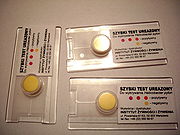
Rapid urease test
Encyclopedia

Helicobacter pylori
Helicobacter pylori , previously named Campylobacter pyloridis, is a Gram-negative, microaerophilic bacterium found in the stomach. It was identified in 1982 by Barry Marshall and Robin Warren, who found that it was present in patients with chronic gastritis and gastric ulcers, conditions that were...
. The basis of the test is the ability of H. pylori to secrete the urease
Urease
Urease is an enzyme that catalyzes the hydrolysis of urea into carbon dioxide and ammonia. The reaction occurs as follows:In 1926, James Sumner showed that urease is a protein. Urease is found in bacteria, yeast, and several higher plants. The structure of urease was first solved by P.A...
enzyme, which catalyzes the conversion of urea
Urea
Urea or carbamide is an organic compound with the chemical formula CO2. The molecule has two —NH2 groups joined by a carbonyl functional group....
to ammonia
Ammonia
Ammonia is a compound of nitrogen and hydrogen with the formula . It is a colourless gas with a characteristic pungent odour. Ammonia contributes significantly to the nutritional needs of terrestrial organisms by serving as a precursor to food and fertilizers. Ammonia, either directly or...
and bicarbonate
Bicarbonate
In inorganic chemistry, bicarbonate is an intermediate form in the deprotonation of carbonic acid...
.
Process
The test is performed at the time of gastroscopyEsophagogastroduodenoscopy
For other expansions of the initialism "OGD", see the disambiguation page.In medicine , esophagogastroduodenoscopy is a diagnostic endoscopic procedure that visualizes the upper part of the gastrointestinal tract up to the duodenum...
. A biopsy
Biopsy
A biopsy is a medical test involving sampling of cells or tissues for examination. It is the medical removal of tissue from a living subject to determine the presence or extent of a disease. The tissue is generally examined under a microscope by a pathologist, and can also be analyzed chemically...
of mucosa is taken from the antrum
Antrum
In biology, antrum is a general term for a cavity or chamber which may have specific meaning in reference to certain organs or sites in the body.In vertebrates, it may mean for example:...
of the stomach
Stomach
The stomach is a muscular, hollow, dilated part of the alimentary canal which functions as an important organ of the digestive tract in some animals, including vertebrates, echinoderms, insects , and molluscs. It is involved in the second phase of digestion, following mastication .The stomach is...
, and is placed into a medium containing urea and an indicator such as phenol red
Phenol red
Phenol red is a pH indicator that is frequently used in cell biology laboratories.-Chemical structure and properties:...
. The urease produced by H. pylori hydrolyzes urea to ammonia, which raises the pH
PH
In chemistry, pH is a measure of the acidity or basicity of an aqueous solution. Pure water is said to be neutral, with a pH close to 7.0 at . Solutions with a pH less than 7 are said to be acidic and solutions with a pH greater than 7 are basic or alkaline...
of the medium, and changes the color of the specimen from yellow (NEGATIVE) to red (POSITIVE).
Limitations
There is evidence to suggest that H. pylori moves proximal in the stomach in patients on therapy with proton pump inhibitors, and, as such, samples from the fundusFundus
Fundus is an anatomical term referring to the portion of an organ opposite from its opening. Examples include:* Fundus * Fundus of gallbladder* Fundus * Fundus...
and antrum
Pyloric antrum
Pyloric antrum is the initial portion of the pyloric part of the stomach. It is near the bottom of the stomach, proximal to the pyloric sphincter, which separates the stomach and the duodenum....
should be taken in these patients.
The specificity and sensitivity of this test is high compared with histopathological examination or urea breath test
Urea breath test
The urea breath test is a rapid diagnostic procedure used to identify infections by Helicobacter pylori, a spiral bacterium implicated in gastritis, gastric ulcer, and peptic ulcer disease. It is based upon the ability of H. pylori to convert urea to ammonia and carbon dioxide...
. The test is often done as part of point-of-care diagnostics, to eliminate the time and expense required to detect H. pylori on pathology
Pathology
Pathology is the precise study and diagnosis of disease. The word pathology is from Ancient Greek , pathos, "feeling, suffering"; and , -logia, "the study of". Pathologization, to pathologize, refers to the process of defining a condition or behavior as pathological, e.g. pathological gambling....
testing.

